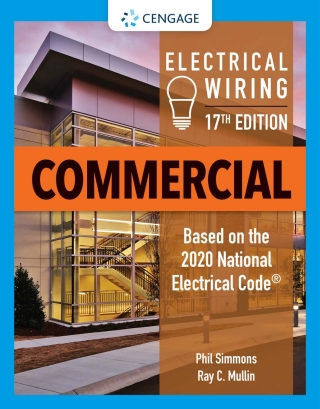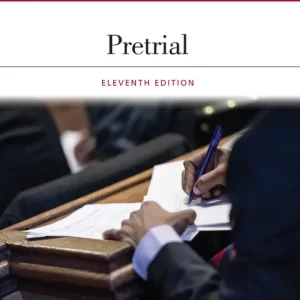Buy Electrical Wiring Commercial, 17th Edition PDF ebook by author Phil Simmons; Ray C. Mullin – published by Cengage Learning in 2021 and save up to 80% compared to the print version of this textbook. With PDF version of this textbook, not only save you money, you can also highlight, add text, underline add post-it notes, bookmarks to pages, instantly search for the major terms or chapter titles, etc.
You can search our site for other versions of the Electrical Wiring Commercial, 17th Edition PDF ebook. You can also search for others PDF ebooks from publisher Cengage Learning, as well as from your favorite authors. We have thousands of online textbooks and course materials (mostly in PDF) that you can download immediately after purchase.
Note: e-textBooks do not come with access codes, CDs/DVDs, workbooks, and other supplemental items.
eBook Details:
Full title: Electrical Wiring Commercial, 17th Edition
Edition: 17th
Copyright year: 2021
Publisher: Cengage Learning
Author: Phil Simmons; Ray C. Mullin
ISBN: 9780357360705, 9780357360705
Format: PDF
Description of Electrical Wiring Commercial, 17th Edition:
Completely revised and updated to reflect the 2020 National Electrical Code (NEC), ELECTRICAL WIRING COMMERCIAL, Seventeenth Edition, offers the most current coverage available. This reader-friendly resource has long been trusted by instructors and popular with students. Filled with vibrant, full-color illustrations and photographs, the text brings even difficult concepts to life and makes complex material easier to understand. In addition to updates based on the 2020 NEC, the Seventeenth Edition features information on important new developments in electrical design and installation, an increased emphasis on green technologies and safety in the workplace, providing ample coverage of topics readers will likely encounter as working professionals in this dynamic field. Providing uniquely practical preparation for real-world success, the text includes a full set of blueprints that walk readers through designing and installing an electrical installation compliant with the latest edition of the NEC.Important Notice: Media content referenced within the product description or the product text may not be available in the ebook version.
Table of Contents of Electrical Wiring Commercial, 17th Edition PDF ebook:
ContentsPrefaceAcknowledgmentsChapter 1: Commercial Building Plans and SpecificationsObjectivesIntroduction to Electrical Wiring-CommercialSafety in the WorkplaceCommercial Building SpecificationsWorking DrawingsCodes and OrganizationsNEC ArrangementLanguage ConventionsDefined TermsAbandoned CablesMetrics (SI) and the NECSummaryReviewChapter 2: Reading Electrical Working Drawings-Entry LevelObjectivesIntroductionElectrical SymbolsThe DrugstoreThe BakeryReviewChapter 3: General Requirements for ConductorsObjectivesConsider Circuit Segments SeparatelyConductor SelectionReviewChapter 4: Branch CircuitsObjectivesDefining the Branch CircuitsOther LoadsUsing the Panelboard Branch-Circuit WorksheetReviewChapter 5: Switches and ReceptaclesObjectivesIntroductionReceptaclesSnap SwitchesOccupancy SensorsNeutral at the Switch LocationSwitch and Receptacle CoversReviewChapter 6: Wiring MethodsObjectivesIntroductionRaceway Sizing in the NECRigid Metal Conduit (RMC)Intermediate Metal Conduit (IMC)Electrical Metallic Tubing (EMT)Raceway SealsFlexible ConnectionsArmored (Type AC) and Metal-Clad (Type MC) CablesRigid Polyvinyl Chloride Conduit (PVC) (NEC Article 352)Electrical Nonmetallic Tubing (ENT) (NEC Article 362)Raceway SizingRaceway SupportSpecial ConsiderationsBox Styles and SizingSelecting the Correct Size BoxReviewChapter 7: Motor and Appliance CircuitsObjectivesMotors and AppliancesThe Basics of Motor CircuitsMotor Branch-Circuit Short-Circuit and Ground-Fault ProtectionMotor-Starting Currents/Code LettersType 1 and Type 2 CoordinationEquipment InstallationAppliancesAppliance Disconnecting MeansGroundingOvercurrent ProtectionThe Bakery EquipmentReviewChapter 8: Feeder Load Calculation and InstallationObjectivesIntroductionThe Electrical LoadEnergy Code ConsiderationsLighting Load CalculationsOther LoadsMotors and AppliancesFeeder RequirementsTap ConductorsFeeder Component SelectionPanelboard Worksheet, Schedule, and Load CalculationFeeder Ampacity Determination, DrugstoreReviewChapter 9: Special SystemsObjectivesIntroductionSurface Metal or Nonmetallic RacewaysMultioutlet AssembliesCommunications SystemsFloor OutletsFire Alarm SystemReviewChapter 10: Working Drawings-Upper LevelObjectivesIntroductionInsurance OfficeBeauty SalonReal Estate OfficeToilet RoomsReviewChapter 11: Special Circuits (Owner’s Circuits)ObjectivesIntroductionPanelboard Worksheet, Panelboard Schedule, and Load Calculation FormLighting CircuitsSump Pump ControlWater Heaters and Space HeatingElevator WiringOptional Electric BoilerReviewChapter 12: Panelboard Selection and InstallationObjectivesIntroductionPanelboardsWorking Space around Electrical EquipmentSummaryReviewChapter 13: The Electric Service and GroundingObjectivesIntroductionTransformersTransformer Overcurrent ProtectionTransformer ConnectionsUtility SupplyMeteringImportant DefinitionsService-Entrance EquipmentGrounding/BondingGround Fault Protection of EquipmentSafety in the WorkplaceReviewChapter 14: Lamps and Ballasts for LightingObjectivesIntroductionLighting TerminologyLumens per Watt (lm/W)Incandescent LampsLow-Voltage Incandescent LampsFluorescent LampsRetrofitting Existing InstallationsHigh-Intensity Discharge (HID) LampsEnergy SavingsHazardous Waste MaterialSummaryReviewChapter 15: LuminairesObjectivesIntroductionInstallationEnergy Savings by ControlLabelingLoading Allowance CalculationsLuminaires in Clothes ClosetsWatts per Unit Area CalculationsReviewChapter 16: Emergency, Legally Required Standby, and Optional Standby Power SystemsObjectivesIntroductionSources of PowerClassification of SystemsSpecial Wiring ArrangementsGenerator SourceTransfer Switches and EquipmentReviewChapter 17: Overcurrent Protection: Fuses and Circuit BreakersObjectivesIntroductionDisconnect SwitchesFuses and Circuit BreakersTypes of FusesTesting FusesDelta, 3-Phase, Corner-Grounded “B” Phase SystemTime-Current Characteristic Curves and Peak Let-Through ChartsCircuit BreakersSeries-Rated ApplicationsSeries-Rated Systems Where Electric Motors Are ConnectedCurrent-Limiting Circuit BreakersCost ConsiderationsMotor CircuitsHeating, Air-Conditioning, and Refrigeration Overcurrent ProtectionReviewChapter 18: Short-Circuit Calculations and Coordination of Overcurrent Protective DevicesObjectivesIntroductionMarking for Service EquipmentMarking Short-Circuit CurrentShort-Circuit CalculationsShort-Circuit Current VariablesCoordination of Overcurrent Protective DevicesSingle PhasingReviewChapter 19: Equipment and Conductor Short-Circuit ProtectionObjectivesIntroductionConductor Short-Circuit Current RatingConductor HeatingCalculating a Conductor’s 75 Degrees Celsius Thermoplastic Insulation Short-Time Withstand RatingCalculating a Bare Copper Conductor and/or Its Bolted Short-Circuit Withstand RatingCalculating the Melting Point of a Copper ConductorUsing Charts to Determine a Conductor’s Short-Time Withstand RatingMagnetic ForcesSummaryReviewChapter 20: Low-Voltage Remote ControlObjectivesEnergy SavingsLow-Voltage Remote ControlWiring MethodsReviewChapter 21: The Cooling SystemObjectivesIntroductionRefrigerationEvaporatorCompressorCondenserExpansion ValveHermetic CompressorsCooling System ControlElectrical Wiring for Cooling System EquipmentElectrical Requirements for Air-Conditioning and Refrigeration EquipmentSpecial TerminologyReviewChapter 22: Commercial Utility-Interactive Photovoltaic SystemsObjectivesIntroductionThe Photovoltaic EffectThe Basic Utility-Interactive Photovoltaic SystemUtility-Interactive Photovoltaic System ComponentsRapid Shutdown of PV Systems on BuildingsUtility-Interactive Photovoltaic PlansUtility-Interactive Photovoltaic System InstallationSystem Checkout and CommissioningSummaryReviewAppendix A: Electrical SpecificationsAppendix B: Useful FormulasAppendix C: NEMA Enclosure TypesAppendix D: Outside Air Temperatures for Selected U.S. CitiesAppendix E: Metric System of MeasurementAppendix F: GlossaryAppendix G: Electrical SymbolsAppendix H: Bender GuideCode IndexSubject Index





